snow chains AUDI S3 2009 Owners Manual
[x] Cancel search | Manufacturer: AUDI, Model Year: 2009, Model line: S3, Model: AUDI S3 2009Pages: 324, PDF Size: 76.02 MB
Page 193 of 324

actual vehicle behavior. If the two do not match, for example when
th e vehicle begins to skid, ESP brakes the appropriate wheel auto
matical ly .
The vehicle is stabilized again by the forces acting on the wheel
during braking. With an oversteering vehicle (tendency for the rear
end to skid out of the curve), the brake application is mainly at the
front wheel on the outside of the curve, with an
understeering
vehicle (tendency to run wide in the curve) at the rear wheel on the
inside of the curve or additionally at the other wheels as needed.
This brake application is accompanied by noises.
ESP works in conjunction with ABS=>
page 194. If there is malfunc
tion in the ABS, ESP is also inoperative.
Activating
The ESP is automatica lly activated when the engine is started, and
it performs a self-test. As soon as the test is completed, the system
is in normal operating mode. With ASR deactivated, or with ESP/ASR
deactivated, pressing the button=>
page 190, fig. 163 returns the
system to normal operation.
Deactivating
ESP should normally be activated at all times because this ensures
optimum vehicle stability. Only in certain exceptional cases it does
make sense to deactivate Anti-Slip Regulation (ASR) or the Elec
tronic Stability Program (ESP) by pressing the button =>
page 190,
fig. 163. Both deactivation stages can only be activated from normal
mode .
Deactivating ASR
Tap the switch . Deactivation is indicated by slow flashing of the ESP
lamp in the instrument cluster. In certain situations (e .g. driving
with snow chains, in deep snow or on loose ground, or when
rocking the car free), it may be necessary to deactivate ASR.
Deactivating ESP/ASR
Press the button for more than 3 seconds. Deactivation is indicated
by the ESP lamp in the ins trument cluster staying on permanently .
Controls and equip
ment Safety first Vehicle operation
Intelligent technology
This
deactivates the Electronic Stability Program (ESP) in addition to
ASR. No Elec tronic Stability System operation and no Anti -Slip
Regulation is available across the entire speed range; ASR and ESP
are activated only when the brakes are used for the duration of the
braking action and remain active until a stable vehicle condition has
been reached. There is no driving situation which requires ESP to be
deactivated, so this should only be done if the driver's skill and the
traffic situation permit.
& WARNING
• The limits of physics cannot be suspended by ESP. Even in vehi
cles with ESP. you should always adapt your driving to road and
traffic conditions. This is particularly true on a slippery and wet
road . Do not be tempted by the increased safety provided to take
risks -danger of an accident!
• Please note that when ASR or ESP /ASR is deactivated , the drive
wheels can spin on icy and slippery roads and the vehicle can
break away -danger of skidding!
[ i ] Tips
In the event of a defect in Audi magnetic ride, it can happen that
ASR and ASR/ESP cannot be deactivated, or they are activated auto
matically in the deactivated state.
Electronic differential lock (EDL)
The electronic differential lock monitors the rotational
speed of the drive wheels.
General notes
The electronic differential lock (EDU helps the car to start moving,
accelerate and c limb a gradient on surfaces providing poor or
a lmost no grip . Without EDL , this would be difficult, if not impos
sib le.
Vehicle care Do-it-yourself service Technical data
Page 195 of 324
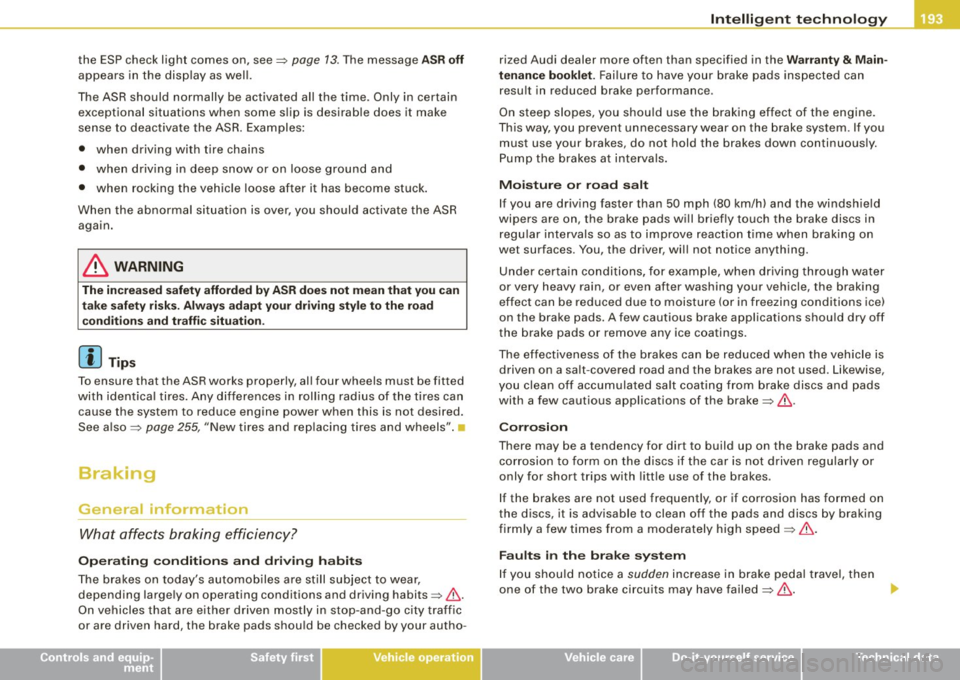
•
the ESP check light comes on, see~ page 13. The message ASR off
appears in the display as well.
The ASR should normally be activated all the time . Only in certain
exceptional situations when some slip is desirable does it make
sense to deactivate the ASR. Examples:
• when driving with tire chains
• when driving in deep snow or on loose ground and
• when rocking the vehicle loose after it has become stuck.
When the abnormal situation is over, you should activate the ASR
again.
& WARNING
The increased safety afforded by ASR does not mean that you can
take safety risks. Always adapt your driving style to the road
conditions and traffic situation.
[ i] Tips
To ensure that the ASR works properly, all four wheels must be fitted
with identical tires. Any differences in rolling radius of the tires can
cause the system to reduce engine power when this is not desired.
See also ~
page 255, "New tires and replacing tires and wheels". •
Braking
General information
What affects braking efficiency?
Operating conditions and driving habits
The brakes on today's automobiles are still subject to wear,
depending largely on operating conditions and driving habits~& .
On vehicles that are either driven mostly in stop-and-go city traffic
or are driven hard, the brake pads should be checked by your autho-
Intelligent technology
rized Audi dealer more often than specified in the Warranty & Main
tenance booklet.
Failure to have your brake pads inspected can
result in reduced brake performance.
On steep slopes, you should use the braking effect of the engine.
This way, you prevent unnecessary wear on the brake system. If you
must use your brakes, do not hold the brakes down continuously.
Pump the brakes at intervals.
Moisture or road salt
If you are driving faster than 50 mph (80 km/h) and the windshield
wipers are on, the brake pads will briefly touch the brake discs in
regular intervals so as to improve reaction time when braking on
wet surfaces. You, the driver, will not notice anything.
Under certain conditions, for example, when driving through water
or very heavy rain, or even after washing your vehicle, the braking
effect can be reduced due to moisture (or in freezing conditions ice)
on the brake pads. A few cautious brake applications should dry off
the brake pads or remove any ice coatings.
The effectiveness of the brakes can be reduced when the vehicle is
driven on a salt-covered road and the brakes are not used . Likewise,
you clean off accumulated salt coating from brake discs and pads
with a few cautious applications of the brake~&.
Corrosion
There may be a tendency for dirt to build up on the brake pads and
corrosion to form on the discs if the car is not driven regularly or
only for short trips with little use of the brakes .
If the brakes are not used frequently, or if corrosion has formed on
the discs, it is advisable to clean off the pads and discs by braking
firmly a few times from a moderately high speed~& .
Faults in the brake system
If you should notice a sudden increase in brake pedal travel, then
one of the two brake circuits may have failed~&. ..,
I t •
Page 198 of 324
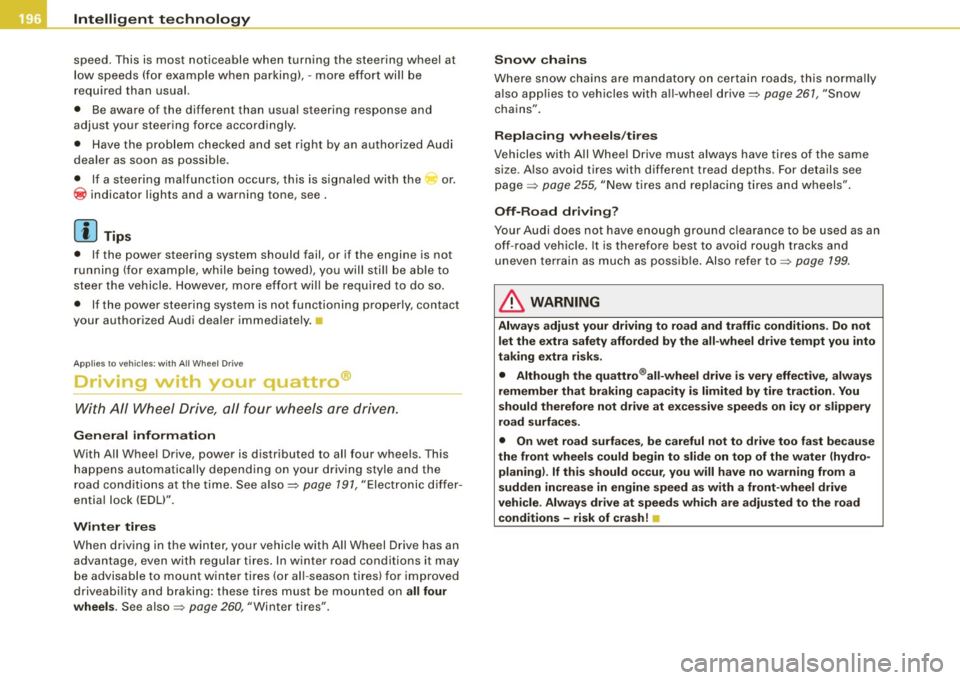
__ _:_:ln..:..t::.: e::.: l~ li :.;:g t:e::..: n..:.. t:...::. te::::..:: c~h :.:.n .:..: o:::.: l:.: o :.;g~ yL- ________________________________________ _
speed. This is most noticeable when turning the steering wheel at
low speeds (for example when parking), -more effort will be
required than usual.
• Be aware of the different than usual steering response and
adjust your steering force accordingly.
• Have the problem checked and set right by an authorized Audi
dealer as soon as possible.
• If a steering malfunction occurs, this is signaled with the or.
@ indicator lights and a warning tone, see.
[ i) Tips
• If the power steering system should fail, or if the engine is not
running (for example, while being towed), you will still be able to
steer the vehicle. However, more effort will be required to do so.
• If the power steering system is not functioning properly, contact
your authorized Audi dealer immediately.
Applies to vehicles: with All Wheel Drive
Driving with your quattro®
With All Wheel Drive, all four wheels are driven.
General information
With All Wheel Drive, power is distributed to all four wheels. This
happens automatically depending on your driving style and the
road conditions at the time. See also::::,
page 191, "Electronic differ
ential lock (EDU".
Winter tires
When driving in the winter, your vehicle with All Wheel Drive has an
advantage, even with regular tires. In winter road conditions it may
be advisable to mount winter tires (or all -season tires) for improved
driveability and braking: these tires must be mounted on
all four
wheels.
See also ::::, page 260, "Winter ti res".
Snow chains
Where snow chains are mandatory on certain roads, this normally
also applies to vehicles with all-wheel drive:::::,
page 261, "Snow
chains".
Replacing wheels/tires
Vehicles with All Wheel Drive must always have tires of the same
size. Also avoid tires with different tread depths. For details see
page ::::,
page 255, "New tires and replacing tires and wheels".
Off-Road driving?
Your Audi does not have enough ground clearance to be used as an
off-road vehicle. It is therefore best to avoid rough tracks and
uneven terrain as much as possible. Also refer to::::,
page 199.
& WARNING
Always adjust your driving to road and traffic conditions. Do not
let the extra safety afforded by the all-wheel drive tempt you into
taking extra risks.
• Although the quattro ®all-wheel drive is very effective, always
remember that braking capacity is limited by tire traction. You
should therefore not drive at excessive speeds on icy or slippery
road surfaces.
• On wet road surfaces, be careful not to drive too fast because
the front wheels could begin to slide on top of the water (hydro planing). If this should occur, you will have no warning from a
sudden increase in engine speed as with a front-wheel drive
vehicle. Always drive at speeds which are adjusted to the road
conditions -risk of crash!
n
Page 263 of 324
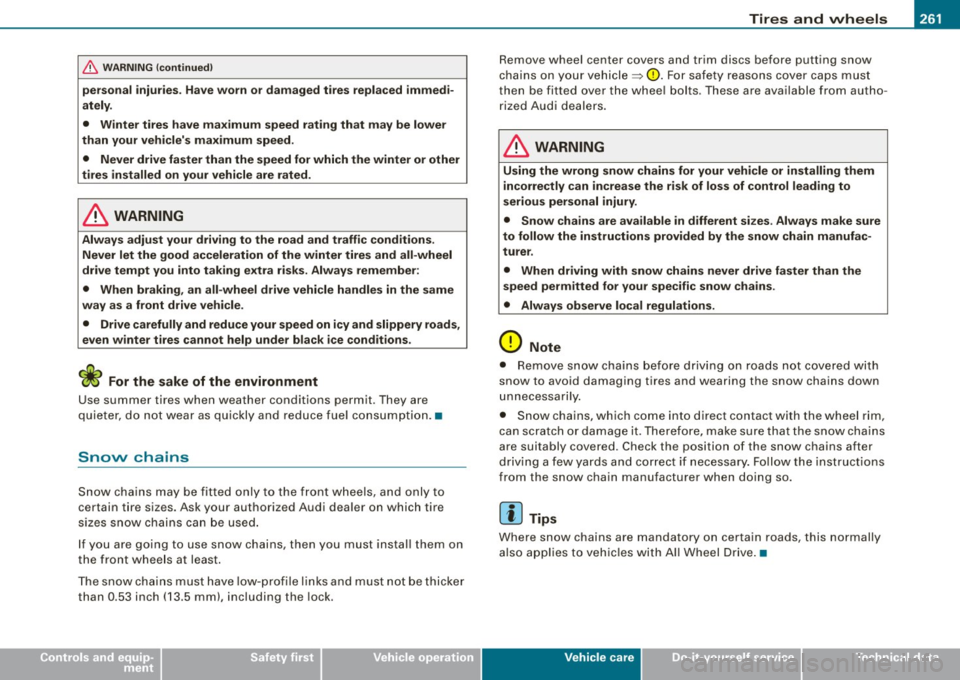
__________________________________________________ T_ ir_e_ s_ a_ n_d _ w_ h_ e_ e_l_s __ _
•
& WARNING (continu ed )
personal injur ies . Have worn or damaged tires repl aced immed i
ately.
• Winter tires have ma ximu m speed rating th at may be lower
than your vehicle 's maximum speed.
• Never drive faster than the speed for which the winter or other
tire s installed on your vehicle are rated.
& WARNING
Alway s adjust your driving to the road and traffi c cond it ions .
Never let the good acceleration of the winter tires and all -wheel
drive tempt you into tak ing e xtra ri sks . Always remember :
• When braking , an all -wheel drive vehicle h andles in the same
way as a front drive vehicle .
• Drive carefully and reduce your speed on icy and slippery roads ,
even winter tires cannot help under black ice conditions.
c£> For the sake of the environment
Use summer tires when weather conditions permit. T hey are
quieter, d o not wear as qu ic kly and reduce fue l con sump tion. •
Snow chains
Snow c ha ins may be fitte d only to t he fr ont w heels , and only to
certain t ire sizes. Ask your authorized Audi dea ler on which tire
s izes snow chains ca n be used .
I f you are going to use snow chains , then you must instal l them on
the front whee ls at least.
The snow chains must have low-pro file l inks and must not be thicker
than 0 .5 3 inch ( 13 .5 mm), including the lock. Remove wheel center covers and trim discs before putting snow
chains o
n yo ur vehicle ~
(D. For safe ty reaso ns cover caps mus t
then be fitted over the whee l bolts . These are available from autho
r iz ed A ud i deale rs.
& WARNING
Using the wrong snow chain s for your vehicle or installing them
inco rrectly can increase the risk of loss of control leading to
serious personal injury.
• Snow chains are ava ila ble in d ifferent si zes . Always make sure
to follow the instructions provided by the snow chain manufac
turer .
• When driving with snow chain s never drive faster than the
speed permitted for your spe cific snow cha ins .
• Always observe local regulations .
0 Note
• Remove snow chai ns before d riving o n roads not cov ered w ith
snow to avoid damaging t ires and wearing the snow chains down
unnecessar ily .
• Snow chains, which come into direct contact with the wheel rim,
can scratch or damage it . Therefore, make sure t hat the s now c hains
are suitably covered. Check the position of the snow chains after
dr iv in g a few ya rds and cor rec t if necessary . Fo llow the i nstruct ions
from the snow cha in manufacturer when do ing so.
[ i ] Tips
Where snow chains are mandatory on certain roads, this normally
a lso a ppl ies to veh ic les wit h All Wheel Drive .•
Vehicle care I t •
Page 270 of 324
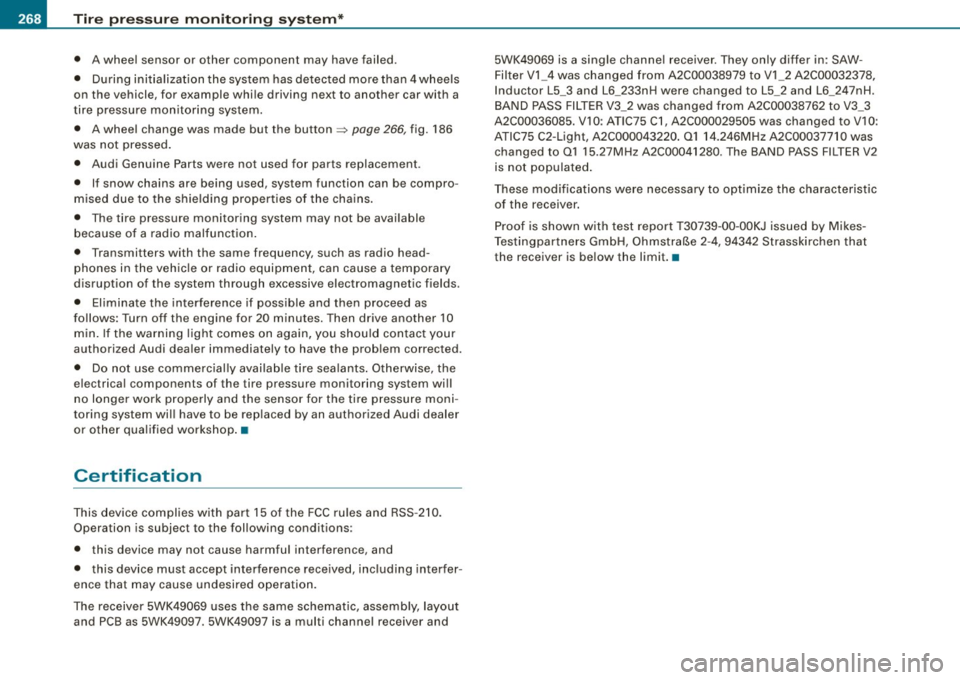
___ T _i_r e_=- p_r_e _ s_ s_ u_r_ e _ m_ o_ n_i_t _o _r_ i _ n .,;:g ::;.._ s_ y=--- s_t _e _m_ * __________________________________________ _
• A wheel sensor or other component may have failed.
• During ini tializat ion the system has detected more tha n 4 wheels
on the vehicle, for example whi le driving next to another car with a
tire pressure monitoring system.
• A wheel change was made but the button
:=:, page 266, fig. 186
was not pressed.
• Audi Genuine Parts were not used for parts replacement .
• If snow chains are being used, system function can be compro
mised due to the shielding properties of the chains.
• The tire pressure monitoring system may not be avai lable
because of a radio malfunction.
• Transmitters with the same frequency, such as radio head
phones in the vehic le or radio equipment, can cause a temporary
disruption of the system through excessive electromagnetic fields .
• Eliminate the interference if possible and then proceed as
follows: Turn off the engine for 20 minutes. Then drive another 10
min. If the warning light comes on again, you shou ld con tact your
authorized Audi dealer immediately to have the prob lem corrected.
• Do not use commercially avai lab le tire sea lants . Otherwise, the
e lectrica l components of the tire pressure monitoring system wi ll
no longer work properly and the sensor for the tire p ressure moni
toring system wil l have to be rep laced by an authorized Audi dealer
or o ther qua lified workshop .•
Certification
This device complies with part 15 of the FCC rules and RSS -210.
Operation is subject to the following conditions:
• this device may not cause harmful interference, and
• this device must accept interference rece ived, including interfer
ence that may cause undesired operation.
The receiver 5WK49069 uses the same schematic, assemb ly, layout
and PCB as 5WK49097 . 5WK49097 is a multi channel receiver and 5WK49069 is a single channe
l receiver . They only differ in : SAW
Filter V1 _4 was changed from A2C00038979 to V1 _2 A2C00032378,
Inductor L5_3 and L6_233nH were changed to L5 _2 and L6 _247nH .
BAND PASS FILTER V3_2 was changed from A2C00038762 to V3_3
A2C00036085. V10 : ATIC75 C1, A2C000029505 was changed to V10 :
ATIC75 C2-Light, A2C000043220 . Q1 14.246MHz A2C00037710 was
changed to Q1 15.27MHz A2C00041280 . The BAND PASS FI LTER V2
is not populated .
These modifica tions were necessary to optimize the characteris tic
of the receiver.
Proof is shown with test report T30739 -00 -00KJ issued by Mikes
Testingpartners GmbH, Ohmstral5e 2-4 , 94342 Strasski rchen that
the receiver is be low the limit .•
Page 273 of 324
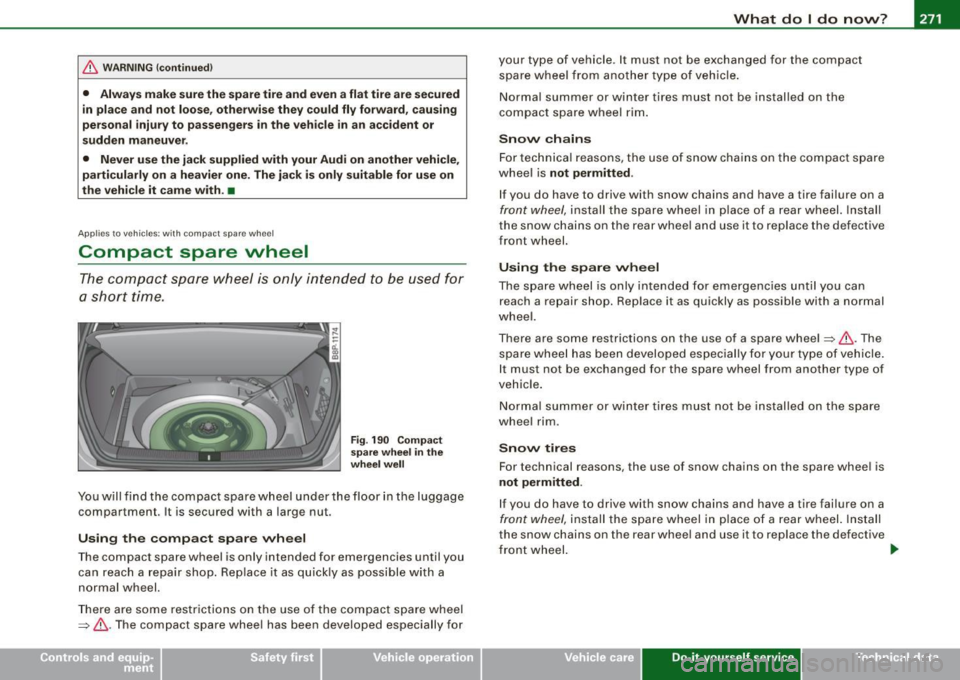
What do I do now? -
------------------
& WARNING !continued)
• Always make sure the spare tire and even a flat tire are secured
in place and not loose, otherwise they could fly forward, causing
personal injury to passengers in the vehicle in an accident or
sudden maneuver .
• Never use the jack supplied with your Audi on another vehicle,
particularly on a heavier one. The jack is only suitable for use on
the vehicle it came with. •
Ap plies to vehicles: w ith compact spare wheel
Compact spare wheel
The compact spare wheel is only intended to be used for
a short Nme.
Fig . 190 Compact
spare wheel in the
wheel well
You will find the compact spare wheel under the floor in the luggage
compartment. It is secured with a large nut.
Using the compact spare wheel
The compact spare wheel is only intended for emergencies until you
can reach a repair shop. Replace it as quickly as possible with a
normal wheel.
There are some restrictions on the use of the compact spare wheel
=>
& -The compact spare wheel has been developed especially for your type of vehicle
. It must not be exchanged for the compact
spare wheel from another type of vehicle.
Normal summer or winter tires must not be installed on the
compact spare wheel rim.
Snow chains
For technical reasons, the use of snow chains on the compact spare
wheel is
not permitted .
If you do have to drive with snow chains and have a tire failure on a
front wheel, install the spare wheel in place of a rear wheel. Install
the snow chains on the rear wheel and use it to replace the defective
front wheel.
Using the spare wheel
The spare wheel is only intended for emergencies until you can
reach a repair shop. Replace it as quickly as possible with a normal
wheel.
There are some restrictions on the use of a spare wheel =>& .The
spare wheel has been developed especially for your type of vehicle.
I t must not be exchanged for the spare wheel from another type of
vehicle.
Normal summer or winter tires must not be installed on the spare
wheel rim .
Snow tires
For technical reasons , the use of snow chains on the spare wheel is
not permitted .
If you do have to drive with snow chains and have a tire failure on a
front wheel, install the spare wheel in place of a rear wheel. Install
the snow chains on the rear wheel and use it to replace the defective
front wheel.
t,.
Vehicle care Do-it-yourself service irechnical data
Page 274 of 324
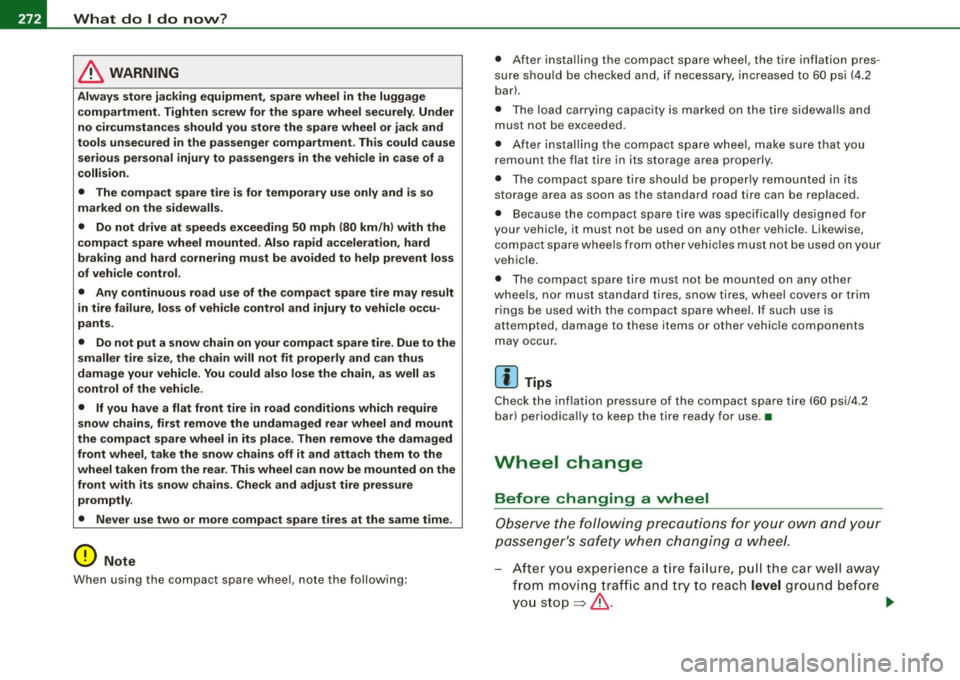
-L___:W:..:..:. h.:.: a::.. t:...:: d:.:o:::....:. l..: d::. O ::::....: n:..:.:: O:..:W :.:..:. ? ____________________________________________ _
& WARNING
Always store jacking equipment, spare wheel in the luggage
compartment. Tighten screw for the spare wheel securely. Under
no circumstances should you store the spare wheel or jack and
tools unsecured in the passenger compartment. This could cause
serious personal injury to passengers in the vehicle in case of a
collision.
• The compact spare tire is for temporary use only and is so
marked on the sidewalls.
• Do not drive at speeds exceeding 50 mph (80 km/hi with the
compact spare wheel mounted. Also rapid acceleration, hard
braking and hard cornering must be avoided to help prevent loss
of vehicle control.
• Any continuous road use of the compact spare tire may result
in tire failure, loss of vehicle control and injury to vehicle occu
pants.
• Do not put a snow chain on your compact spare tire. Due to the
smaller tire size, the chain will not fit properly and can thus
damage your vehicle. You could also lose the chain, as well as
control of the vehicle .
• If you have a flat front tire in road conditions which require
snow chains, first remove the undamaged rear wheel and mount
the compact spare wheel in its place. Then remove the damaged
front wheel, take the snow chains off it and attach them to the
wheel taken from the rear. This wheel can now be mounted on the
front with its snow chains. Check and adjust tire pressure promptly.
• Never use two or more compact spare tires at the same time.
0 Note
When using the compact spare wheel, note the following: •
After installing the compact spare wheel, the tire inflation pres
sure should be checked and, if necessary, increased to 60 psi (4 .2
barl.
• The load carrying capacity is marked on the tire sidewal ls and
must not be exceeded .
• After installing the compact spare wheel, make sure that you
remount the flat tire in its storage area properly .
• The compact spare tire should be properly remounted in its
storage area as soon as the standard road tire can be replaced.
• Because the compact spare tire was specifically designed for
your vehicle, it must not be used on any other vehicle . Likewise,
compact spare wheels from other vehic les must not be used on your
vehicle.
• The compact spare tire must not be mounted on any other
wheels, nor must standard tires, snow tires, wheel covers or trim
rings be used with the compact spare wheel. If such use is
attempted, damage to these items or other vehicle components
may occur.
[ i] Tips
Check the inflation pressure of the compact spare tire (60 psi/4 .2
bar) periodically to keep the tire ready for use .•
Wheel change
Before changing a wheel
Observe the following precautions for your own and your
passenger's safety when changing a wheel.
- After you experience a tire failure, pull the car well away
from moving traffic and try to reach level ground before
you stop
~ & . ~
Page 320 of 324
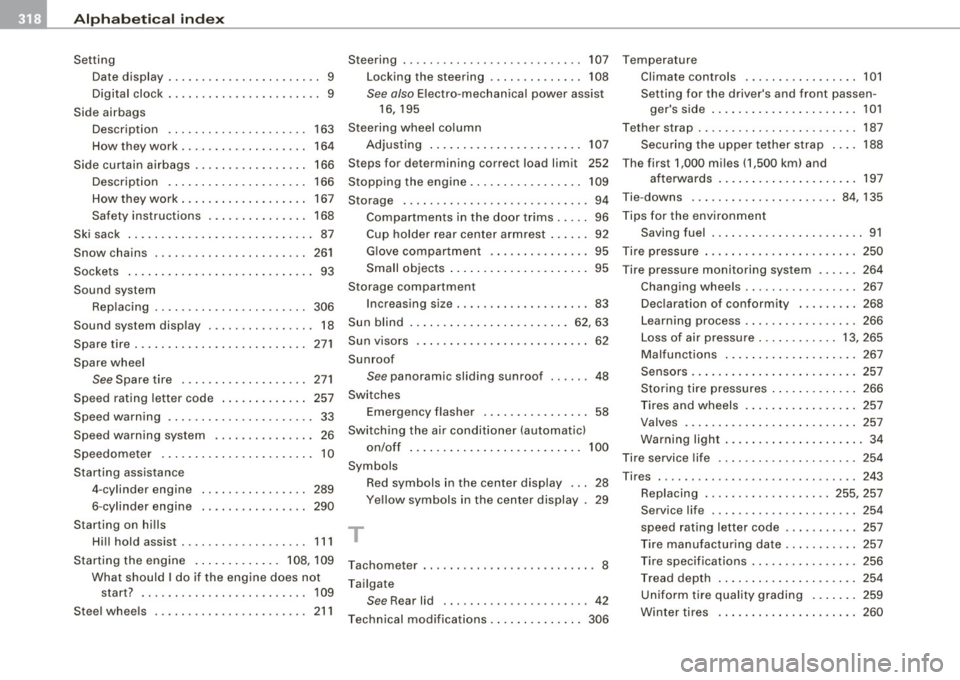
___ A_ l..:,. p _ h_ a_ b_e _t_ic _ a_l _in _ d_e_ x ____________________________________________ _
Setting
Date display . .... ... ... .. ... ... .... 9
Digital clock ........... .... ..... ...
9
Side airbags
Description ... .... .... ... .... ... 163
How they work . . . . . . . . . . . . . . . . . . . 164
Side curtain airbags ...... ....... .... 166
Description . ...... .... .......... 166
How they work . . . . . . . . . . . . . . . . . . . 167
Safety instructions . . . . . . . . . . . . . . . 168
Sk i sack ..................... ....... 87
Snow chains . . . . . . . . . . . . . . . . . . . . . . . 261
Sockets ............. .... .... ... .... 93
Sound system Replacing . .... .... .... ... .... ... 306
Sound system display .... .... .... .... 18
Spare tire . . . . . . . . . . . . . . . . . . . . . . . . . . 271
Spare wheel
See Spa re tire . . . . . . . . . . . . . . . . . . . 271
Speed rating letter code . . . . . . . . . . . . . 257
Speed warning ... .... .... ... .... .... 33
Speed warning system ...... .... .... . 26
Speedometer . . . . . . . . . . . . . . . . . . . . . . . 10
Star ting assistance
4-cylinder engine
6 -cylinder engine
Star ting on hi lls 289
290
Hill hold assis t ........ ....... .... 111
Starting the engine ....... .... .. 108, 109
What should I do if the engine does not
start? . . . . . . . . . . . . . . . . . . . . . . . . . 109
St ee l whe els . . . . . . . . . . . . . . . . . . . . . . . 21 1 Steering
. . . . . . . . . . . . . . . . . . . . . . . . . . . 107
Locking the steering . . . . . . . . . . . . . . 108
See also Electro-mechanical power assis t
16, 195
Steering wheel column Adjusting ..... ... ..... .... .... .. 107
St eps for d eter mining correc t load limit 252
Stopping the engine ................. 109
Storage . .... .... ..... .. .... ..... ... 94
Compartments in the door tr ims .. ... 96
Cup holder rear center armrest ...... 92
G love compartment . ...... .... .... 95
Small objects .......... ....... .... 95
Storage compartment Increasing size ....... .... ... .. .... 83
Sun blind .. ...... .. .. .... .... .... 62, 63
Sun visors .. ...... ....... .... .... ... 62
Sunroof
See panoramic sli din g sunroof ...... 48
Switches Emergency flasher . . . . . . . . . . . . . . . . 58
Switching the air cond itioner (automatic)
on/off ... . ..... ................. 100
Symbols
T
Red symbols in the center display ... 28
Ye llow symbols in the center display . 29
Tachometer .. .... ...... .... ... .. .... . 8
Tailgate
See Rea r lid ... ... .... .... .... .... 42
Technical modifications .. ............ 306 Temperature
Clima te controls .. .... ...... ... .. 101
Setting for the drive r's and front passen-
ger's side ..... ....... ...... .... 101
Tether strap .. .... .... ... .... .... ... 187
Securing the upper tether strap .... 188
The first 1,000 mil es (1,500 km) and
afterwards .... .. .... .... .... ... 197
Tie-downs . . . . . . . . . . . . . . . . . . . . . . 84 , 135
Tips for the environment
Saving fuel .. ...... .... .. .. .... ... 91
Tire pressure ...... .... ......... .... 250
Tire pressure monitoring system ...... 264
Changing wheels ............ ..... 267
Declaration of conformity . ........ 268
Learning process ... .... ...... .... 266
Loss of air pressure . .... ... .. .. 13,265
Malfunctions ... .. .... .... .... .. . 267
Sensors . . . . . . . . . . . . . . . . . . . . . . . . . 257
Storing tire pressures .......... .. . 266
Tires and wheels .. ... .. .. .. ..... . 257
Valves ...... ...... .... ...... .... 257
Warning light ... .. .... .... .... .... 34
Tire service life .... .... ... ..... ... .. 254
Tires ........... ..... ....... ....... 243
Replacing . .... .... .... ...... 255, 257
Service life ...... .... .... .... .... 254
speed rating letter code ... .... .... 257
Tire manufacturing date .... .... ... 257
Tire specif ications ........ .. .... .. 256
Tread depth .. .......... .... ..... 254
Un iform tire quality grading ... .... 259
Winter tires .. ....... .. .. .. .... .. 260
Page 321 of 324

______________________________________________ A_ l_,_ p _h_ a_ b_e _t_i c_ a _ l _in _ d_e _ x __ lll
T ires and vehicle load limits
Tires and wheels 251
Checking tire pressure ... .... ..... 250
Co ld tire inflation pressure ... .. .... 247
Dimensions ..................... 255
General notes . ............ ... .... 243
G lossary of tire and loading termino logy
244
New tires and whee ls ... .. ... .... . 255
Replacing . ...... ..... .. .... .... . 256
Snow chains ............. .... .... 261
T ire pressure monitoring system ... 257
T ires and vehicle load limits .... .... 25 1
Wheel bo lts .. .... ....... ...... .. 262
Winter tires ...................... 260
T ires/Wheels
Low aspect ratio tires .... .... .... . 262
T ire pressure monitoring system 13, 264
Torn or frayed safety belts .... .... .... 140
T ouch -up paint
Tow ing 210
F ront eyelet ...... .... ... .... .... 293
Rear eyelet ... .... .... ... .... .... 293
T ow truck procedures ............. 292
Trailer towing . ...... .... ... .... .... 202
Operating instruc tio ns . ...... .... . 203
Techn ical req uir emen ts ... ... . 202, 203
Tr aile r towing tips ... .... .... .... . 20 4
T ransmiss ion
6 -speed . . . . . . . . . . . . . . . . . . . . . . . . . 116
Manual tra nsmission .. ...... .... . 116
S tronic transmiss ion .. ...... .... . 117
Transport Canada ................... 136
Controls and equip
ment Safety first
T
read Wear Indicator (TWI) .. .. .. .... . 254 w
Trip co mputer ...... .... .... .... ... .. 22
Trip odometer ....................... 10 Warning
light
What does it mean when dEF appears in Tire p
ressure monitoring system ..... 34
the trip odometer display? ......... 10 Warning lights ..................... 8, 11
Turn signals ..... ... .... .... .... .... . 59 Red symbols in the center display
.... 28
Warning/indicator lights ...... ...... 1 4 Ye
llow symbols in the center display . 29
Warning/ind ica tor lights
u Airbag system .... .... ..... .. .... . 1 4
Anti-lock brake system (ABS) ...... .. 16
Unde rc o ating .. ...... .... .... .... ... 213
Brake system ..... ... .... .... ..... 15
Unfastening safety belts ............. 144
Cruise control ..................... 14
Unidirectiona l ti res ...... .... .... .... 243 Electronic power control
............ 13
Uniform tire quality gradi ng ... ....... 259 Electronic stabilization program (ESP) 13
Un locking Generator
.... ... .... ... . .. .. ..... 14
Power locking switch .... ... .... ... 41 High beam
.... ....... ........ .... 14
Rear lid .. .... ... .... ... ... ...... . 42 Malfunction Indicator Lamp (M
IU .. .. 13
Remote control ................... 39 Parking brake
..................... 15
Us ing the fold -out key ..... ......... 40 Safety belt ..
...... .... .... .... .... 15
Tire p ressure monitoring syste m .... . 13
V Turn signals ...... .... .... .... .... 1 4
Warranty coverages ................. 303
Vanity mirror ....... .... .... .... ..... 62
Washer reservoir ... .. .... ..... .. .... 241
Vehic le battery
Washing ........................... 206
Stationary .... ........ ........ ... 237
Automatic car wash . ...... .... ... . 207
Vehic le e lec trical system ... .. .... ... .. 14 by hand .... ... .. .... .... .... .... 207
Vehicle identification ..... ..... ...... 298 General
infor mat ion ...... .... ... . 206
Vehic le identification ll abel .. ...... .... 298 with a power washer
...... .... .... 208
Veh icle Ident ification !Number (VIN) .... 298 Wax
ing .. ................... .... ... 209
Vehicle jack .................... 270, 276 Wear indicator
...................... 254
Veh ic le l iterature . ...... .... ..... .. .... 4 Weatherstrips
.... .... ... .... .... ... 21 1
Vehic le -care products ....... ......... 206 Weights ..
.... ....... .... ... .... .... 299
Vehicle operation Vehicle care Do-it-yourself service Technical data